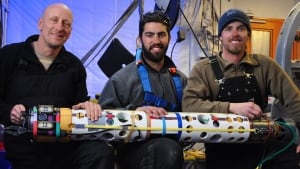Beneath the Ross Ice Shelf, off the Antarctic coast, unsuspecting geologists discovered a trove of life in a place that was thought to be completely inhospitable.
Scientists and engineers with the Antarctic Geological Drilling (ANDRILL) Program at the University of Nebraska-Lincoln discovered that the underside of the ice shelf was covered with thousands of small sea anemones — a new species that have somehow burrowed into the dense ice.
Sea anemones
Some species of sea anemones are filter feeders that reach their tentacles out into the water column like nets in search of tiny food particles that float by, while other species paralyze and eat fish using the same stingers as their jellyfish cousins.
"I had no idea that there was anything living there. From what I know about anemone biology, I would not have thought it was possible," says Marymegan Daly, associate professor of evolution, ecology and organismal biology, specializing in sea anemones at Ohio State University.
Sea anemones are related to jellyfish. With about 1500 described species, they are abundant in almost every ocean habitat on earth, "from the highest parts of the intertidal [zones] where they're exposed to air part of the day … to the deepest parts of the ocean," says Daly.
Anemones range in size from less than two centimetres to more than one metre in diameter, but many species are about the size of a tea cup. In the water, anemones look a lot like plants, but they are in fact carnivorous animals.
The Antarctic expedition
The team went to the Ross Ice Shelf for the spring and summer in Antarctica, beginning in October 2010 and staying until February 2011.

When completely retracted, the anemone, Edwardsiella andrillae, is about two centimetres long. (Courtesy Frank Rack)
Temperatures at the McMurdo research station rose from about -30 C to a balmy 0 C as the summer progressed.
Using a hot water drill, the team "melted holes through 250 to 270 metres of ice," before reaching liquid water underneath, says Frank Rack, executive director of the ANDRILL Science Management Office and associate professor at the University of Nebraska-Lincoln.
The goal of this expedition was to get geologic samples of the sea floor and to test their new remotely operated vehicle camera equipment.
But when the robot went down into the liquid water, "the ice looked fuzzy," says Rack. When the team drifted the rig up for a closer look, "that's when they discovered the anemones sticking out of the ice."
As geologists and engineers, the team didn't come prepared with a way to collect the anemones — after all, they didn't expect to see any life stuck to the underside of the ice.
Can shrink to 2 cm long
Rack says "[the team] just used pieces of the vehicle, they took a thruster and a piece of tubing and a Braun coffee filter," as an improvised suction sampler, and specimens were sent along with pictures to Daly for identification.
'[I]f you take an anemone, even one that lives in Antarctic waters, and you put it in the freezer, surrounded by ice, it will die'- Marymegan Daly, Ohio State University
The brilliantly white anemones that speckled the ice, now named Edwarsiella andrillae in honour of the ANDRILL program, can extend to about seven centimetres long with their tentacles reaching into the fast-flowing water stream to filter out tiny particles to eat. Or they can shrink down to about two centimetres long and fully retreat into the ice for protection.
"The water temperature right under the ice is about -2 degrees [Celsius]," says Rack, and within the burrows in the ice where the anemones live, it's probably even colder.
Daly says that "if you take an anemone, even one that lives in Antarctic waters, and you put it in the freezer, surrounded by ice, it will die," but these anemones are thriving.
When Rack's team drilled a second hole 10 kilometres away from the first one, they discovered the same garden of anemones was still blanketing the underside of the ice.

Members of an Antarctic drilling team, from left: Bob Zook, Paul Mahecek and Dustin Carroll, hold the underwater robot that was used to discover the sea anemone. (Frank Rack)
Because they were found at two separate sites, "these anemone fields are probably pretty big," says Daly.
Since the anemones were found in such huge numbers, and in such an unlikely place on Earth, Rack and Daly are both left with questions about where this new species of anemone came from and how it is able to survive under the ice.
After publishing this finding in the journal PLoS ONE, Daly got emails from other researchers who have done research in Antarctica, one study dating back to the 1970s, with anecdotes about how they have also noticed "something that might be these anemones."
"Nature has a way of showing us how little we know," says Daly.
According to a press release, the discovery of these anemones has even sparked the interest of NASA because this discovery could illuminate the possibility of life that may exist under the ice on Jupiter's moon, Europa.
Anda sedang membaca artikel tentang
Sea anemones found living beneath Antarctic ice shelf
Dengan url
http://teknounikmenarik.blogspot.com/2014/01/sea-anemones-found-living-beneath.html
Anda boleh menyebar luaskannya atau mengcopy paste-nya
Sea anemones found living beneath Antarctic ice shelf
namun jangan lupa untuk meletakkan link
Sea anemones found living beneath Antarctic ice shelf
sebagai sumbernya
0 komentar:
Posting Komentar